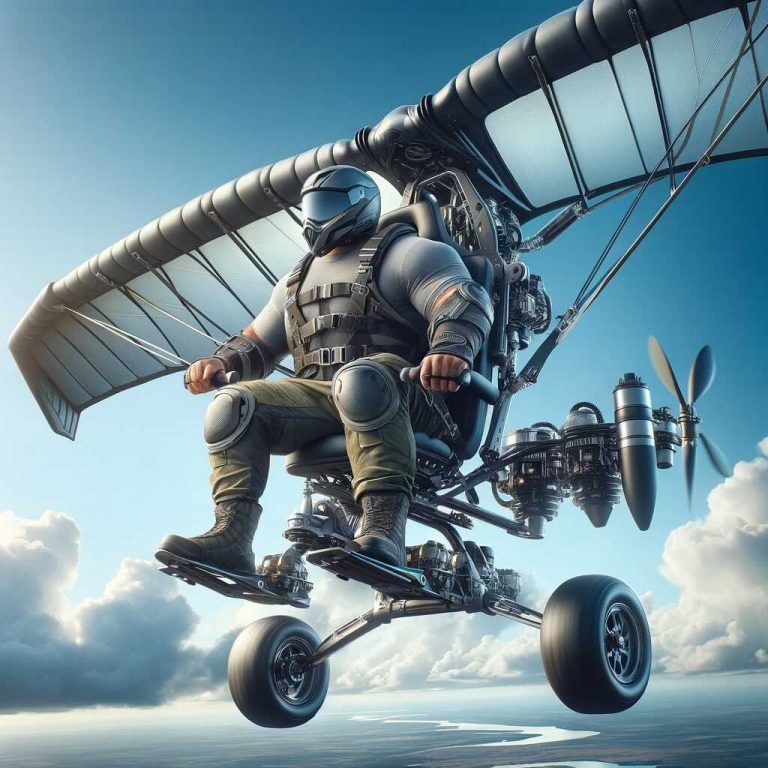If you’re considering entering the thrilling world of paramotoring, you’re in for an exhilarating adventure! Paramotoring combines the freedom of powered flight with the simplicity of paragliding, offering a unique and accessible way to take to the skies. One of the most critical decisions you’ll make on your paramotoring journey is selecting the right wing. In this comprehensive guide, we’ll explore the key factors to consider when choosing the best beginner paramotor wing to ensure you start your journey safely and confidently.
Understanding the Basics: What is a Paramotor Wing?
Before we dive into the specifics of choosing a paramotor wing, let’s start with the basics. A paramotor wing, also known as a paraglider wing or canopy, is a large fabric wing that attaches to your paramotor frame. It’s the primary component that generates lift and allows you to glide through the air.
Paramotor wings are designed to be highly efficient and stable, enabling pilots to take off, fly, and land safely. They come in various sizes, shapes, and designs, each catering to different flying styles and skill levels.
The Importance of Selecting the Right Beginner Paramotor Wing
Choosing the right paramotor wing is crucial for several reasons:
- Safety: Safety should always be your top priority when engaging in any form of aviation. A well-suited beginner wing will offer stability and forgiving characteristics, reducing the chances of accidents and mishaps.
- Ease of Learning: A beginner-friendly wing will make the learning curve less steep, allowing you to progress more quickly and comfortably in your paramotoring journey.
- Enjoyment: The right wing can enhance your overall flying experience, making it more enjoyable and rewarding.
- Longevity: A good beginner wing can serve you well as you gain experience and become a more skilled pilot. It’s an investment in your paramotoring future.
Now, let’s explore the factors you should consider when selecting the best beginner paramotor wing.
Factors to Consider When Choosing a Beginner Paramotor Wing
1. Wing Size (Wing Area)
The size of a paramotor wing is typically measured in square meters (m²). Wings come in a range of sizes, from small, agile wings to larger, more stable ones. For beginners, it’s generally advisable to start with a larger wing, as they tend to be more forgiving and provide better stability.
When determining the appropriate wing size, consider your weight, the weight of your paramotor equipment, and the altitude and weather conditions of your flying area. An experienced paramotor instructor can help you calculate the right wing size for your specific circumstances.
2. Wing Design (Aspect Ratio)
The aspect ratio of a wing is the ratio of its wingspan to its average chord (width). Wings with a higher aspect ratio tend to be more efficient and provide better glide performance. However, they can also be less stable, making them less suitable for beginners.
Beginner paramotor wings typically have a lower aspect ratio, which makes them more stable and forgiving. These wings are often designed for ease of inflation, takeoff, and landing.
3. Certification
Paramotor wings are certified by organizations such as the DHV (Deutscher Hängegleiter Verband) and the EN (European Norm) standards. These certifications indicate that the wing has undergone rigorous testing and meets specific safety and performance criteria.
For beginners, it’s advisable to choose a wing that is certified as suitable for beginner pilots. These wings are designed with safety in mind and are more forgiving of pilot errors.
4. Weight Range
Each paramotor wing is designed to accommodate a specific weight range. It’s essential to choose a wing that is appropriate for your weight and the weight of your paramotor setup. Flying with a wing that is too small or too large for your weight can result in poor handling and compromised safety.
Consult with a paramotor instructor or the wing’s manufacturer to ensure you select a wing that falls within your weight range.
5. Inflation and Launch Characteristics
Beginner paramotor wings should have excellent inflation and launch characteristics. This means they should be relatively easy to inflate and take off, even in light or variable wind conditions. Look for wings with a reputation for smooth and predictable launches.
6. Stability
Stability is paramount for beginner pilots. A stable wing is less likely to exhibit sudden or unexpected behaviors, making it easier for you to control. Beginner wings are designed to provide a high degree of stability, even in turbulent air.
7. Speed and Handling
While stability is crucial, you also want a wing that offers reasonable speed and handling characteristics. Some beginner wings may sacrifice speed for stability, but it’s essential to strike a balance that suits your flying style. Discuss your preferences with your instructor to find a wing that matches your needs.
8. Price and Budget
Paramotor wings come in a wide range of prices, and it’s essential to consider your budget. Keep in mind that, as a beginner, you may not want to invest in the most expensive wing right away. Many reputable brands offer quality beginner wings at affordable prices.
9. Brand and Reputation
Choosing a well-established and reputable brand can provide additional peace of mind. Brands with a history of producing reliable and safe paramotor wings are often a good choice for beginners.
10. Personal Goals
Consider your personal goals and aspirations in paramotoring. Are you looking to progress quickly and eventually engage in more advanced maneuvers, or are you primarily interested in leisurely flights? Your goals can influence your choice of wing.
Top Beginner Paramotor Wings
To help you get started on your search for the best beginner paramotor wing, here are a few popular options known for their beginner-friendly characteristics:
1. Ozone Mojo PWR
- Wing Type: Beginner
- Aspect Ratio: 4.8
- Certification: EN A / DGAC
- Weight Range: 65-140 kg (S) / 85-145 kg (M) / 105-155 kg (L)
The Ozone Mojo PWR is well-regarded for its stability and ease of use. It’s an excellent choice for beginners who want a wing that will instill confidence from the start.
2. Gin Bolero 6
- Wing Type: Beginner / Intermediate
- Aspect Ratio: 4.85
- Certification: EN A
- Weight Range: 65-85 kg (XS) / 75-95 kg (S) / 85-105 kg (M) / 95-115 kg (L) / 110-130 kg (XL)
The Gin Bolero 6 is known for its comfortable handling and predictable flight characteristics. It’s suitable for both beginners and pilots looking to progress to intermediate levels.
3. Niviuk Koyot 3
- Wing Type: Beginner
- Aspect Ratio: 4.85
- Certification: EN A
- Weight Range: 60-75 kg (XS) / 70-95 kg (S) / 85-105 kg (M) / 100-130 kg (L)
The Niviuk Koyot 3 offers a high degree of stability and excellent launch characteristics. It’s a solid choice for beginners who want to build their skills gradually.
4. Advance Alpha 6
- Wing Type: Beginner / Intermediate
- Aspect Ratio: 5.0
- Certification: EN A
- Weight Range: 70-90 kg (XS) / 80-100 kg (S) / 90-110 kg (M) / 105-130 kg (L)
The Advance Alpha 6 is praised for its safety features and ease of use. It’s suitable for beginners but also offers room for progression as you gain experience.
Tips for Choosing Your Beginner Paramotor Wing
Now that you have an understanding of the key factors to consider and some top options to explore, here are some additional tips to help you make an informed decision:
- Consult with an Instructor: Your paramotor instructor is a valuable resource when choosing a wing. They can assess your skills and goals and recommend a wing that aligns with your needs.
- Demo Wings: Whenever possible, try out different wings before making a final decision. Many paramotor schools and manufacturers offer wing demo programs, allowing you to get a feel for how a particular wing handles.
- Read Reviews: Research online reviews and forums to gather insights from other paramotor pilots who have experience with the wings you’re considering. Their feedback can provide valuable information.
- Consider Resale Value: While it may not be your primary concern as a beginner, some wings hold their value better than others. If you plan to upgrade to a different wing in the future, this can be an important factor.
- Safety First: Remember that safety should always come first. It’s better to start with a wing that may be slightly conservative than one that pushes the limits of your skills as a beginner.
- Take Your Time: Don’t rush the decision-making process. It’s worth investing the time and effort to find the wing that feels right for you.
Conclusion
Selecting the best beginner paramotor wing is a critical decision that can significantly impact your paramotoring experience. Safety, stability, and your personal goals should be the guiding factors in your choice. Take the time to research and consult with experts to ensure you find a wing that suits your needs and allows you to embark on your paramotoring journey with confidence.
Remember that paramotoring is an incredible adventure, and with the right wing, you’ll be soaring through the skies and experiencing the freedom of flight like never before. Enjoy your paramotoring journey and stay safe in the air!








